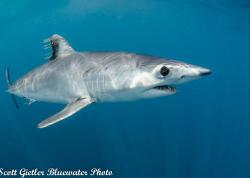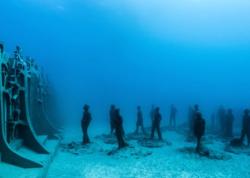Giant Manta Rays Protected as a Migratory Species
Giant Manta Rays Protected as a Migratory Species
UN Conservation Convention Accepts Ecuador Proposal to List Largest Living Rays to CMS Appendix I & II
By Eric Aubort
BERGEN, Norway, Nov. 25, 2011- Shark Advocates International is heralding today's agreement by Parties to the Convention on Migratory Species of Wild Animals (CMS) to list the giant manta ray (Manta birostris) under CMS Appendix I and II.

Protection Guidelines:
- The listing obligates CMS member countries to provide strict national protections for giant manta rays and their habitats, and encourages concerted conservation action among Range States. Manta rays are under increasing threat from targeted fisheries driven by East Asian demand for their gill rakers for use in Chinese medicine.
From Shark Advocates International:
- "We are elated that the CMS Parties have embraced Ecuador's proposal for protecting the magnificent and exceptionally vulnerable giant manta ray," said Sonja Fordham, President of Shark Advocates International. "CMS is an excellent vehicle for facilitating much needed national and international safeguards for this wide-ranging, globally threatened species."
Habitats:
- Giant manta rays are found in tropical, sub-tropical, and temperate waters around the world, often along coasts and offshore islands. Some sub-populations number just a few hundred individuals. The greatest threat to manta rays is fishing; their large size, slow movements, and predictable aggregations make them easy targets. Manta rays are protected in Hawaii, Maldives, Philippines, Mexico, Ecuador, Yap, Western Australia, and New Zealand, but migrate into unprotected waters of other countries and the high seas. Today's decision marks the first international agreement aimed at conserving manta rays and should spark new protections in key Range States such as Mozambique, India, Sri Lanka, and Peru.
Biology:
- Manta rays can grow to more than seven meters across. Females are thought to produce just one pup after a year-long pregnancy. Manta rays feed on plankton filtered through their gills using comb-like projections known as 'gill rakers'. Demand for gill rakers is reportedly resulting in dramatic increases in targeted manta ray fisheries and subsequent depletion of some local populations.
Conservation Benefits:
-
Manta ray eco-tourism generates significant economic benefits for local communities across the globe, particularly in Maldives, Mozambique, and Hawaii. A new study estimates the worldwide value of manta-based tourism and filming at US$100 million per year.
The European Union, Senegal, Madagascar, Australia, United States, Chile, Mozambique, Uruguay, and Norway expressed support for the proposal.
Source:
- Shark Advocates International (SAI) is a project of The Ocean Foundation established to advance sound policies for sharks and rays.
- Liz Morley, +1-843-693-5044, info@sharkadvocates.org
Further Reading
Support the Underwater Photography Guide
Please support the Underwater Photography Guide by purchasing your underwater photography gear through our sister site, Bluewater Photo & Video. Click, or call them at (310) 633-5052 for expert advice!
RECOMMENDED ARTICLES
SUPPORT THE UNDERWATER PHOTOGRAPHY GUIDE:
The Best Service & Prices on u/w Photo Gear
 Visit Bluewater Photo & Video for all your underwater photography and video gear. Click, or call the team at (310) 633-5052 for expert advice!
Visit Bluewater Photo & Video for all your underwater photography and video gear. Click, or call the team at (310) 633-5052 for expert advice!
The Best Pricing, Service & Expert Advice to Book your Dive Trips
 Bluewater Travel is your full-service scuba travel agency. Let our expert advisers plan and book your next dive vacation. Run by divers, for divers.
Bluewater Travel is your full-service scuba travel agency. Let our expert advisers plan and book your next dive vacation. Run by divers, for divers.
































